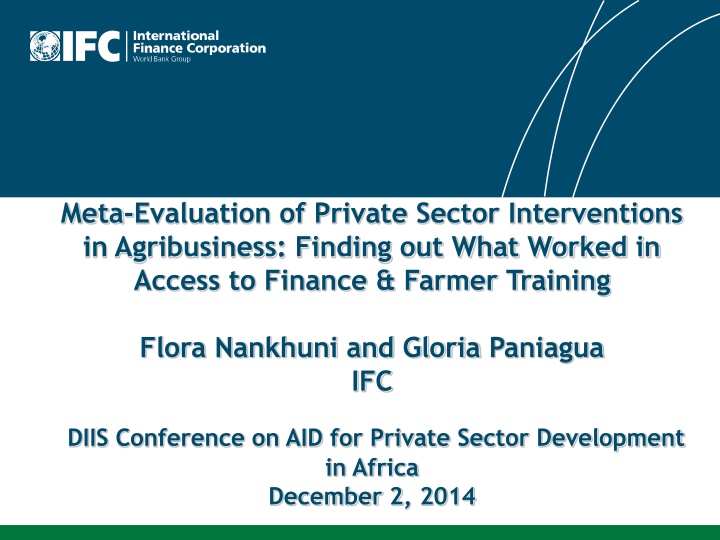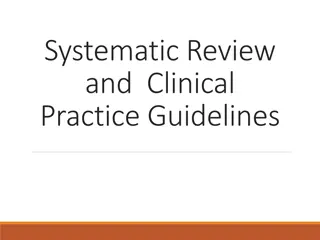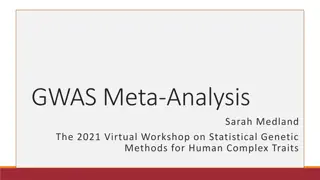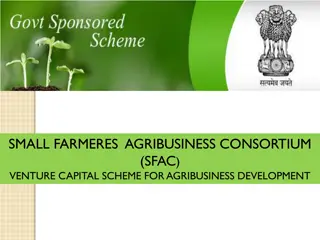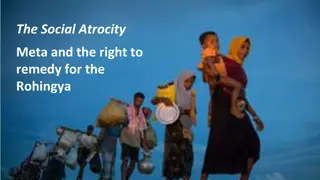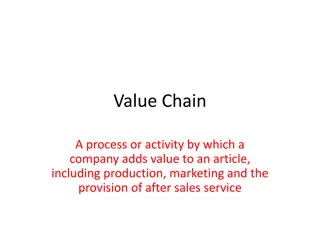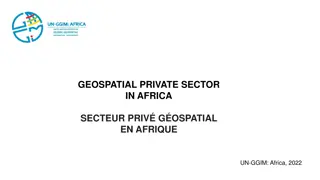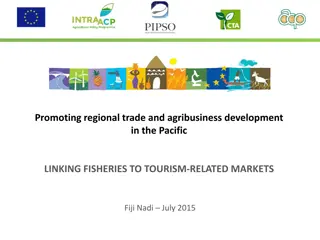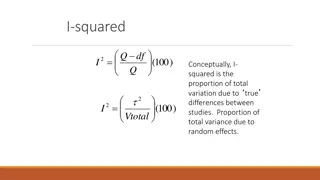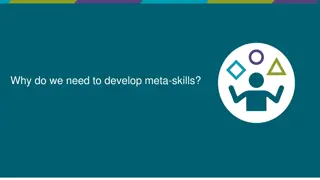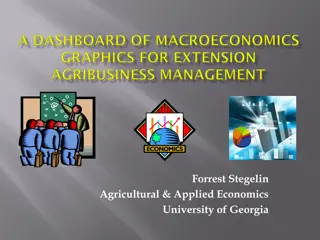Meta-Evaluation of Private Sector Interventions in Agribusiness: Impacts and Methodologies
This meta-evaluation study explores the impact of access to finance and farmer/business training interventions on agribusiness indicators. It discusses the methodologies used in evaluations, highlighting the use of randomized control trials and quasi-experimental methods. Findings provide insights into the effectiveness of these interventions and offer recommendations for future assessments in the private sector development context.
Download Presentation

Please find below an Image/Link to download the presentation.
The content on the website is provided AS IS for your information and personal use only. It may not be sold, licensed, or shared on other websites without obtaining consent from the author.If you encounter any issues during the download, it is possible that the publisher has removed the file from their server.
You are allowed to download the files provided on this website for personal or commercial use, subject to the condition that they are used lawfully. All files are the property of their respective owners.
The content on the website is provided AS IS for your information and personal use only. It may not be sold, licensed, or shared on other websites without obtaining consent from the author.
E N D
Presentation Transcript
Meta-Evaluation of Private Sector Interventions in Agribusiness: Finding out What Worked in Access to Finance & Farmer Training Flora Nankhuni and Gloria Paniagua IFC DIIS Conference on AID for Private Sector Development in Africa December 2, 2014
Outline Methodology used Questions addressed 1. What is the Impact of Access to Finance and Farmer/Business Training Interventions on Agribusiness Indicators? 2. What Methodologies/Approaches have been used to conduct the evaluations? What lessons and findings can inform DIIS? Based on three examples from the systematic review and one example from a recent ongoing evaluation 2
Methodology Initial search on keywords 66 22 851 Literature reviews, meta/sector evaluations, systematic reviews, etc. Pre-screening title and abstract with 9 interventions 300 Consultation with stakeholders Access to Finance (63) Selection of IE s with 2 interventions 137 Farmer/Business Training (74) Quality Assessment Access to Finance (19) Selected IE s with 2 interventions 44 Farmer/Business Training (27)
What Methodologies/Approaches Have Been Used to Conduct the Evaluations? Access to Finance (credit and insurance) Nine of the evaluations used Randomized Control Trials (RCTs) Ten used quasi-experimental methods: Propensity Score Matching (PSM) and other Matching methods, Instrumental Variable Estimation (IV), Other Regression Analyses (Panel data and Fixed Effects Models) Farmer/Business Training Six of the evaluations used Randomized Control Trials (RCTs) Four used randomized roll-out/phase in (the 4 MCC evaluations) Twenty one used quasi-experimental methods 5
1. What is the Evidence for the Impact of Access to Finance and Farmer/Business Training Interventions on Agribusiness Indicators? 6
1. What is the Evidence for the Impact of A2F and Farmer/Business Training Interventions on Agribusiness Indicators? Table 1: Number and Percentage of A2F Evaluations Measuring Outcomes and Impacts and Results Reported Number (and percentage) of evaluations showing Results Measurement Level positive, zero, negative, and mixed impacts) Total + 0 - Mixed* Increased knowledge, technology adoption, cultivation of profitable crops 13 (100%) 10 (77%) 0 (0%) 0 (0%) 3 (23%) Increased production, productivity, farm income, value of production, profits 13 (100%) 8 (62%) 0 (0%) 0 (0%) 5 (38%) Increased consumption, poverty reduction 9 (100%) 6 (67%) 3 (33%) 0 (0%) 0 (0%) Table 2: Number and Percentage of Farmer/Business Training Evaluations Measuring Outcomes and Impacts and Results Reported Number (and percentage) of evaluations showing Results Measurement Level positive, zero, negative, and mixed impacts) Total + 0 - Mixed* Increased knowledge, technology adoption, cultivation of profitable crops 19 (100%) 13 (68%) 0 (0%) 0 (0%) 6 (32%) Increased production, productivity, farm income, value of production, profits 24 (100%) 10 (42%) 3 (13%) 0 (0%) 11 (46%) Increased consumption, poverty reduction 9 (100%) 2 (22%) 4 (44%) 0 (0%) 3 (33%) Note*: Mixed results are those where some indicators (in that grouping) are positive, others are zero. 7
What Works and What Does Not Work? Successful projects address farmer constraints along the whole value chain. Bolwig S, Gibbon P, Jones S. 2009. The Economics of Smallholder Organic Contract Farming in Tropical Africa. World Development 37(6): 1094 1104. Interventions include: Kawacom Sipi organic (certified) Arabia coffee contract farming/scheme in northern slopes of Mount Elgon in Kapchorwa district in Eastern Uganda. Main intervention is to ensure that farmers comply with EU and US standards of organic certification. This involves: Locally employed field officers conducting farm inspections annually/semi- annually During the inspections, they could offer TA and monitor performance of the farmers in terms of compliance to the standards and other project requirements Provision of training through demonstration farms and occasional training Collection of the coffee from designated collection points Kawacom buys ALL the coffee produced by the certified organic farmers and pays a premium for high quality coffee 8
What Works and What Does Not Work? Cont.. Successful projects address farmer constraints along the whole value chain. Bolwig et al. 2009. The Economics of Smallholder Organic Contract Farming in Tropical Africa. Interventions cont.: Kawacom provides market price information to farmers through cell phones Kawacom provides inputs (on a very limited scale) The Impact Evaluation compared outcomes for Treatment 1-Certified organic farming Treatment 2-Certified organic farming and application of organic farming practices Control- Non-certified contract farming 9
What Works and What Does Not Work? Cont.. Successful projects address farmer constraints along the whole value chain. Bolwig et al. 2009. The Economics of Smallholder Organic Contract Farming in Tropical Africa. Results Scheme participation (organic certification) is associated with an increase in net revenue of ~ 75% on average, this is equivalent to ~ 12.5% of mean (total) household revenue. Applying each additional organic technique generates ~9% of net coffee revenue Conclusion Kawacom was successful because market access was assured incentives and compliance to meeting export standards were put in place farmers were trained and supervised in organic coffee farming transportation from collection points was provided market information was provided, through cell phones credit was provided although on a limited basis. 10
What Works and What Does Not Work? Cont.. Successful projects address farmer constraints along the whole value chain. Bolwig et al. 2009. The Economics of Smallholder Organic Contract Farming in Tropical Africa. Conclusion cont. Other enabling factors include New tarmac road significantly improved accessibility to the area Mobile phone coverage was available Donor funding supported the project (mainly Sida) The company started out in 1996 as a small company in rented premises to become a market leader recognized for high quality Robusta and Africa Arabica coffee, owning its own processing units and buying stations throughout Uganda. Its coffee is certified by Krav Kontrol, Organic Crop Improvement Association (OCIA) and Utz Kapeh (www.kawacom.com). 11
What Works and What Does Not Work? Cont.. Successful projects address farmer constraints along the whole value chain. Asharf N, Gine X, Karla D. 2008. Finding Missing Markets (and a disturbing epilogue): Evidence from an Export Crop Adoption and Marketing Intervention in Kenya. World Bank Policy Research Working Paper 4477. The World Bank, Washington: DC. Problems identified: Farmers not taking advantage of export opportunities that existed. Most were producing for the local market and/or personal consumption. This could be due to: Information gaps about existence of the export market opportunities; Lack of access to capital needed to switch to the export market; Inadequate infrastructure to transport crops to urban centers/exporters; Concern over risky export markets 12
What Works and What Does Not Work? Cont.. Successful projects address farmer constraints along the whole value chain. Finding Missing Markets (Asharf et al. 2008) cont. Interventions included: Drumnet (a local Kenyan NGO) linked the farmers to commercial banks, retail farm suppliers, transport services and the exporter. To qualify, the farmers had agree to attend self-help group meetings, express interest in growing the export crops that Drumnet was marketing, namely French beans, baby corn and passion fruit. 4 week training for the farmers (on financing, selling process and good agricultural practices) At harvest time, Drumnet negotiated prices with the exporter and arranged pick up of produce from pre-specified collection points. The exporter paid Drumnet who in turn deducted any loan repayment, cost of Drumnet services to the farmer and credited the remainder to the farmers bank account. 13
What Works and What Does Not Work? Cont.. Successful projects address farmer constraints along the whole value chain. Finding Missing Markets (Asharf et al. 2008) . The Impact Evaluation Self Help Group Education on good farming practices x Savings account with a local Bank x Group Credit for agricultur al supplies x Sample size Treatment- credit Treatment- no credit Control x 373 x x x - 377 x - - - 367 Results: In the year when the IE was conducted, Drumnet was successful in promoting horticultural exports i.e. treatment farmers were 19.2 percentage points more likely to be growing an export crop. 14
What Works and What Does Not Work? Cont.. Successful projects address farmer constraints along the whole value chain. Finding Missing Markets (Asharf et al. 2008) . Results cont: There were statistically significant impacts on income for first time growers of the export-oriented crops but not on the whole sample of treated farmers. Lack of sustainability: Authors of the evaluation reported that: one year after the evaluation ended, farmers were unable to obtain EU export certifications (EurepGap) and the exporter stopped purchasing their crops. This led to DrumNet scollapse as farmers export crops were left to rot and loans went into default. Farmers returned to growing for local markets, underscoring the original concerns over export market risk Conclusion: Failure to ensure market access and certification standards caused the whole (otherwise successful) value chain to collapse. 15
What Works and What Does Not Work? Cont.. Successful projects address farmer constraints along the whole value chain. Fortson K, Rangarajan A, Blair R, Lee J, Gilbert V. 2012. Evaluation of Water-to-Market Training in Armenia. Mathematica Policy Research and Millennium Challenge Corporation (MCC), at www.mcc.gov Problems Identified Following Armenian government s adoption of a comprehensive stabilization and reform program in which farmland was privatized and redistributed as small plot: beneficiaries of the redistribution had little expertise in farming or had mainly worked on collective farms before the reform and as a result did not have the knowledge required to effectively manage their own farms. Much of the irrigation infrastructure continued to deteriorate, falling into disrepair and disuse US government granted government of Armenia $236 million for rehabilitation of rural roads and irrigated agriculture (2007-2011) 16
What Works and What Does Not Work? Cont.. Successful projects address farmer constraints along the whole value chain. Fortson et al. 2012 Evaluation of Water-to-Market Training in Armenia. Interventions Training for On-Farm Water Management (OFWM) to 45,000 farmers Included classroom and practical (demonstration plots) training on cost effective irrigation technologies. Classroom training was for 3-4 days and was also provided over the life of the compact (2007-2011). It also included tours of farmers Training for High-Value Agriculture (HVA) to 36,000 farmers Included classroom and practical training for high value crop substitution and cropping intensity Training for post-harvest, processing, and marketing, including food safety and food quality standards, financial analysis, and developing commercial linkages Limited access to credit only trained farmers that qualified (for drip irrigation and green house technologies) 17
What Works and What Does Not Work? Cont.. Successful projects address farmer constraints along the whole value chain. Fortson et al. 2012 Evaluation of Water-to-Market Training in Armenia. Results No significant impacts on adoption rates. Only simple technologies were adopted e.g. modified fallow spacing, preparation of irrigated land or having a copy of the farm s WUA contract. Few farmers adopted medium improvements such as gated pipes or advanced improvements such as drip irrigation. There was no evidence that training increased the area of irrigated land In the HVA, there were no impacts on crops being cultivated, no change in production and no change in sales, agricultural income and household income. Therefore no change on poverty rates. 18
What Works and What Does Not Work? Cont.. Successful projects address farmer constraints along the whole value chain. Fortson et al. 2012 Evaluation of Water-to-Market Training in Armenia. What went wrong? The extensive training was not tailored to specific needs of farmers it was a numbers game. Most of the farmers trained did not qualify for the credit to invest in irrigation infrastructure There were problems with sequencing of complementary interventions. The irrigation component was delayed, causing trained farmers unable to use their training because there was no access to water. 19
What Works and What Does Not Work? Cont.. Successful projects address farmer constraints along the whole value chain. The East Africa Dairy Development (EADD) Project. Is a consortium of 5 organizations that are addressing different parts of the dairy value chain ICRAF (World Agroforestry Center) is responsible for the feeding component (production of fodder etc. for increased milk production). They introduced the Volunteer Farmer Trainer Extension model where the project trains a farmer who then trains other farmers in the village (on a voluntary basis). African Breeding Service (distributor of ABS Global Inc. / American Breeding Services) are responsible for artificial insemination and animal health services Heifer International is the main implementing agency Technoserve is responsible for the business/marketing side (e.g. selecting areas with high business potential, they use a Business HUB model where farmers are organized into Dairy businessmen, sometimes they own their own chilling plant, they get inputs on credit that get deducted from their sales of milk, they can own shares in the business) ILRI (International Livestock Research Institute) do the M&E 20
What Works and What Does Not Work? Cont.. Successful projects address farmer constraints along the whole value chain. The East Africa Dairy Development (EADD) Project. Cont. Is funded by the Bill and Melinda Gates Foundation (BMGF) The Consortium was born following some of the above organizations response to a call for proposals by the BMGF First phase 2008-2013 -$42.8 million plus $8 million extra support during an extension phase -- targeting 179,000 farming families ~ 1million individuals in Kenya, Uganda and Rwanda Second phase 2013-2018 $25.5 million targeting an additional 136, 000 farming family in Kenya, Uganda, and Tanzania Goal: To double dairy income of the farmers by 2018. 21
What Works and What Does Not Work? Cont.. Successful projects address farmer constraints along the whole value chain. The East Africa Dairy Development (EADD) Project. Cont. Results: No IE conducted to show if income of farmers increased Field visits by our evaluation team showed that most farmers have increased their milk productivity by 2-3 times (liters / cow/day) compared to when they joined the EADD. By October 2014, 82 farmer-owned dairy enterprises established, reflecting $8.3 million in equity investments by more than 200,000 smallholder farmers in Kenya, Uganda and Rwanda. Overall, EADD-supported businesses have earned $131 million in revenue since 2008, with farmers earning $113 million for milk deliveries - (http://www.technoserve.org/our-work/projects/east-africa-dairy- development#sthash.MFKXrG0c.dpuf) 22
Conclusions It is possible to reach a large number of smallholder farmers by providing AID through private companies (whether based in the country providing the AID or in the recipient country or a combination) The company can also be created for purposes of the project (e.g. the EADD) Good extension services that are geared towards the needs of farmers are a crucial part of the success (e.g. the VFT) It is crucial to address all aspects of the value chain including certification standards for export crops 24
Thank you for your time For more information, please contact: Flora Nankhuni at fnankhun@yahoo.com or Gloria Paniagua at gpaniagua@ifc.org 25
